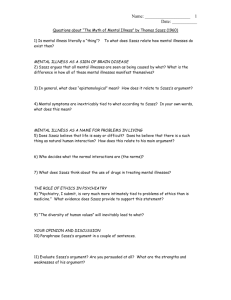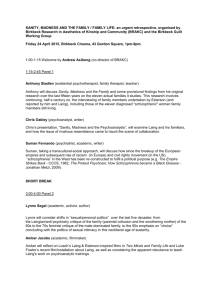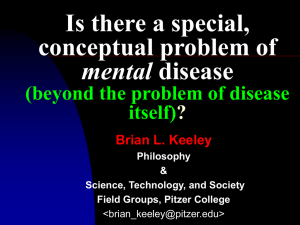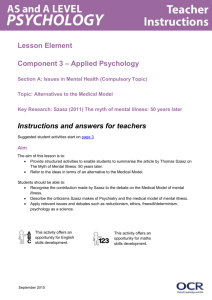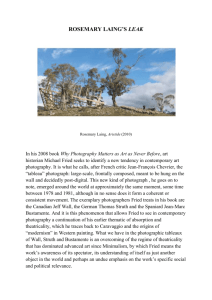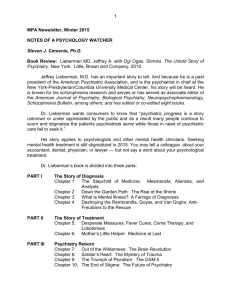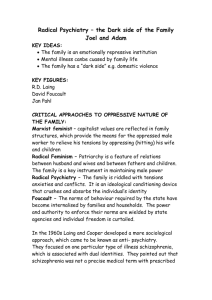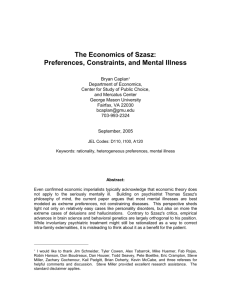Laing And Szasz: - Ittentheodor.ch
advertisement
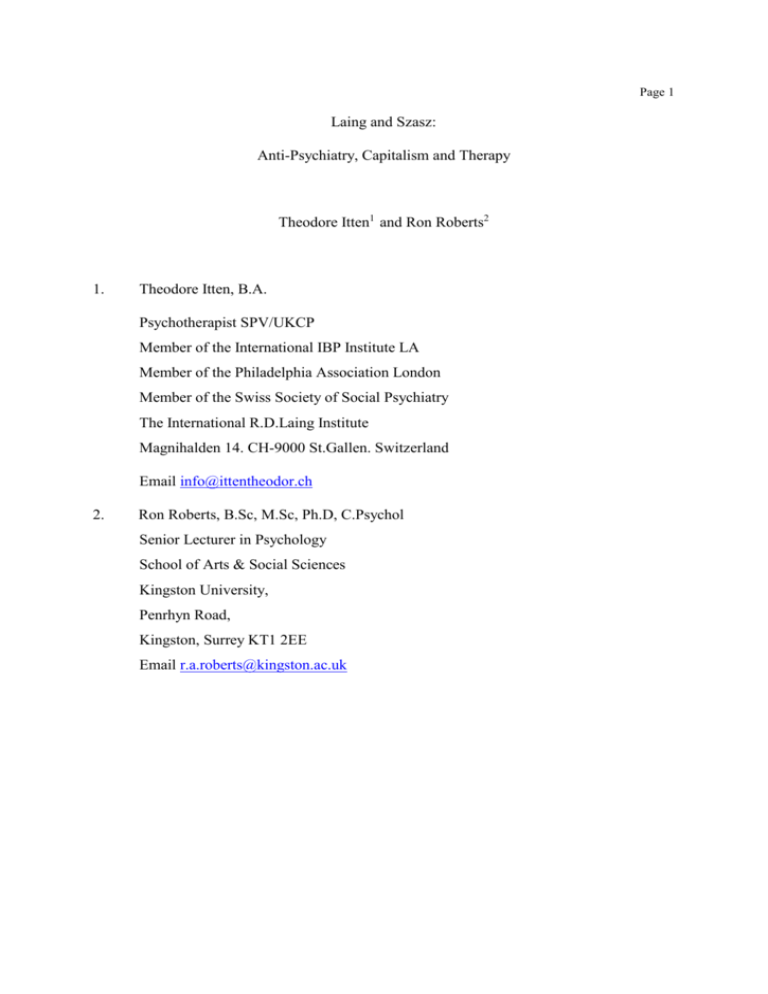
Page 1 Laing and Szasz: Anti-Psychiatry, Capitalism and Therapy Theodore Itten1 and Ron Roberts2 1. Theodore Itten, B.A. Psychotherapist SPV/UKCP Member of the International IBP Institute LA Member of the Philadelphia Association London Member of the Swiss Society of Social Psychiatry The International R.D.Laing Institute Magnihalden 14. CH-9000 St.Gallen. Switzerland Email info@ittentheodor.ch 2. Ron Roberts, B.Sc, M.Sc, Ph.D, C.Psychol Senior Lecturer in Psychology School of Arts & Social Sciences Kingston University, Penrhyn Road, Kingston, Surrey KT1 2EE Email r.a.roberts@kingston.ac.uk Page 2 Abstract Szasz and Laing have been bracketed together as the leading figures in what continues to be called the anti-psychiatry movement. This paper explores the points of convergence in their ideas – principally the coercive and violent nature of orthodox psychiatric practise and the unwarranted medicalisation of behaviour - as well as examining the main points of contention between them. It is suggested that the antipathy Szasz directed toward Laing arose primarily from his perception of Laing as a communist, and therefore in direct opposition to the free market philosophy which underlies Szasz’s libertarian views. A further major difference can be found in their respective approaches to therapy. Szasz aimed to morally reorient clients into taking greater responsibility – the lack of which he saw as underpinning their difficulties, while Laing recognised the existence of extremely disturbed states of mind as constituting madness and endeavoured to render intelligible the behaviour and experience manifested by people in these states. Thus for Laing there was an existential reality to madness which Szasz denies, rejecting the entire notion of madness alongside the myth of mental illness. Page 3 “(Laing) places himself squarely midstream of the main current of contemporary thought and sentiment about ‘health care.’ This current, in both communist and capitalist countries is now fully Marxist - adopting, for ‘suffering situations,’ the famous formula: ‘From each according to his abilities, to each according to his needs’ “(Szasz, 1979a, p.51). “Laing’s criticism of the existing social order is similar, in all essential respects to that of Marxism and Communism” (Szasz, 1979a, p.55). Introduction For many the names of Szasz and Laing are synonymous with the critiques of modern psychiatry that began in the 1960's and became bracketed under the rubric of ‘antipsychiatry’. It may be surprising for some to learn that neither had any allegiance to the term - a phrase that was in fact coined by Laing’s former colleague David Cooper (Cooper, 1967, 1968) to Laing’s consternation; “I have never called myself an anti-psychiatrist, and have disclaimed the term from when first my friend and colleague, David Cooper, introduced it. However, I agree with the anti-psychiatric thesis that by and large psychiatry functions to exclude and repress those elements society wants excluded and repressed. If society requires such exclusion then exclusion it will get. Many psychiatrists want psychiatry to bow out of this function. In Italy,...some have done so; more would do so in other countries, but it is not easy. Such a complete change of policy requires as complete a change of outlook, and that is rare.” (Laing 1985, pp. 8-9) Despite their common cause in attacking the medicalisation of human distress and the coercive nature of psychiatry, Szasz has frequently expressed considerable antipathy towards Laing. To understand the tensions which existed between them it is necessary to examine the Page 4 respective philosophical and political traditions within which their work is situated. First of all however - we will review exactly where their views did converge and why it was that people came to consider them as fellow travellers in the struggle against institutional psychiatry. Anti-Psychiatry Szasz (1970) remarked that it was folly to speak of the abuses of institutional psychiatry, for institutional psychiatry was itself an abuse, as “harming persons categorized as insane is its essential function” (1970, p.xxix). Laing and Cooper likewise drew attention to the inherently violent nature of orthodox psychiatry, with its methods of insulin coma, psychosurgery, electric shock treatment and tranquilising drugs. In Laing’s biography ‘Wisdom, Madness and Folly’ (Laing, 1985) it is clear that his confrontation, early in his career with the sheer brutality of conventional psychiatric treatment led him to seek alternative frameworks for encapsulating and dealing with the problems of human misery. He writes “those who have seen through this to some extent see it as a system of violence and counter-violence. People called brain surgeons have stuck knives into the brains of hundreds and thousands of people in the last twenty years: people who may never have used a knife against themselves; they may have broken a few windows, sometimes screamed, but they have killed fewer people than the rest of the population, many many fewer if we count the mass extermination of wars, declared and undeclared, waged by the legalized ‘sane’ members of our society” (Laing, 1968, p.19). So Laing and Szasz’s initial point of agreement centres on the violent nature of the institution of psychiatry. However even here, there are indications of fundamental differences in their respective outlooks. For Szasz (1961, 1970) the violence of modern psychiatry finds its counterpart in the historical violence of the Inquisition, sanctioned by the Catholic Church Page 5 to wage war on witches and witchcraft, functioning to maintain the hegemony of the church through the social upheavals wrought by feudalism. The transition from a feudal to a capitalist order sees the detective and persecutory functions of the Inquisition, transformed from hunting witches, expropriated by the medical fraternity who, again for the good of society, adopt the new role of identifying and persecuting the mad. Both inquisitor and institutional psychiatrist are aided in their efforts by their respective magnum opii. For the inquisitors this is the Malleus Maleficarum – the witch hunters manual, for modern psychiatrists the Diagnostic and Statistical Manual of Mental Disorders is their particular aide noir. Laing however – as we have seen above, contrasts the violence of psychiatry, with the lesser violence of psychiatric patients and simultaneously with the orchestrated violence of the state. This is of note, because although in the Middle Ages, Szasz’s principal reference point, the church and state were synonymous, the modern organised state now functions as part of the global capitalist order, its actions subordinated to the imperatives of the international economic system and its citizens subject accordingly to an individualist, consumerist ethic. To Szasz, whether in earlier or modern times, it is individuals who are directly victimised by the machinations of the inquisitorial/psychiatric system in order to uphold the status quo. In Laing’s eyes also, the subjugation of individuals through unwanted state/psychiatric interference serves to mystify the nature of problems in the social order. But here their responses to such an analysis are radically different. Szasz’s goals pose no challenges to the larger social order – merely that psychiatric hegemony be abolished (Szasz, 1998), leaving unchallenged the larger capitalist individualist order. His desired interventions are confined to what he describes as ‘contractual psychiatry’ – economically regulated transactions between those who seek help and non-medically oriented psychotherapists who Page 6 offer it, with no state interference in these activities. In contrast, Laing’s analyses proceeded from initial investigations of the internal life of designated ‘troubled’ individuals to wider concerns, social relationships, the nature and organisation of society and the institutions within it. In his words “ I began to see that I was involved in the study of situations and not simply of individuals” (Laing, 1968, p.17). Laing’s analysis raises questions regarding the ideology within which family groupings and other forms of social organisation are regulated. Szasz’s does not. Secondly both Szasz and Laing recognised the inappropriateness of the medical metaphor as applied to human behaviour. Szasz (1960, 1961) famously described the very idea of mental illness as a myth. In so far as both men refused to accept the metaphor of mental illness as biological reality and described some of the social processes and consequences of medicalisation, their approaches can be said to be deconstructionist in flavour. The difficulties which brought people to seek help from mental health professionals were to be better described as problems of living – a phrase originally coined by Szasz (1960) though one with which Laing would have wholeheartedly concurred. Laing’s own linguistic take on this would be that the experiences and behaviours regarded as indicative of mental illness were really “strategies that a person invents in order to live in an unlivable situation” (Laing, 1967, p95). Szasz’s brand of deconstructionist thought however differs markedly from Laing’s. Whereas Laing’s use of social phenomenology (Laing and Esterson, 1964, Laing, 1971) sought to bring intelligibility to the process of going mad and to the experiences and behaviour of those considered mad, Szasz has been more concerned to unravel the intelligibility of the medico-legal and socio-legal functions of mental health institutions and how these have evolved from the early days of the asylum. He has not been concerned with explaining the behaviour, even less the experience of actual persons deemed to be mad. Both Page 7 of these projects are in essence historical and together can be said to constitute a geneology of madness covering both macro and microsocial domains. For Laing the social institutions for dealing with madness were players enmeshed in a social/family drama enacted over successive generations, though an understanding of this history; the unending creation and dissolution of alliances, threats, counter threats, stratagems, rules, roles, memories, metaphors, and myths was, beyond a mere three generations, want to dissolve in the shroud of historical mist. ‘Truth’ was thus constrained by the limits of memory, as much as by any Orwellian subterfuge that may be operational in the social sphere. Laing is here following Sartre, in inserting the dynamics of microsocial processes into the wider macrosocial history (Laing and Cooper, 1964), and following Sartre this project is avowedly Marxist in its character and in its method of analysis. The focus is on where the power lies within the family. Szasz’s interest, in contrast, is with power and the legal constraints operating on this power, in the wider society. The fundamental conflicts in human life are between those “who hold power and use it to oppress others, and those who are oppressed by power and seek to free themselves of it” (Szasz, 1970, p.63). In comparing institutional biological psychiatry to the rest of medical practise, Szasz has been criticised for giving too much credence to ordinary physical medicine as an enterprise grounded in value free scientific facts (Megone, 2000), underplaying the constructionist nature of much of what we take to be ‘real medicine’ in comparison to it’s poorer cousin of psychiatry. Laing has not been so restrictive and throughout his career launched repeated salvoes against the destructiveness and heartlessness of the scientific method – inside and outside of medicine. Curiously Szasz has eschewed any in-depth analysis of the socio-economic basis of medical, psychiatric, or psychotherapeutic power. He is imbued with a mission to enlighten us solely about psychiatric power; “The empire of psychiatric power is more than three Page 8 hundred years old and grows daily more encompassing. But we have not yet begun to acknowledge its existence, much less to understand its role in our society” (Szasz, 1997a, p.497) and again; “who else exercises such vast discretionary powers over his fellow man as the contemporary psychiatrist?” (1970, p.62). Well, without disagreeing with Szasz’s views regarding the pernicious nature of psychiatric power and its widespread penetration into the social fabric, there is indeed another institution which exercises power on a still greater scale, which carries the power of life and death and which has also seeped into the fabric of daily life. This is the power of the military. Szasz’s blindness to armed force as the ultimate coercive sanction is all the more interesting, given that his most forceful writings were penned in an era in which the US military-industrial complex was heavily involved in wars throughout South East Asia and its security forces at home were policing internal dissent. Szasz is no doubt correct in imputing to psychiatry the function of enforcing conformity with state interests, but his own alignment with ‘free market’ interests (See Szasz, 2003) appears to have prevented him from realising that the logic of conformity or adherence to free market ideology leads inevitably to state force, the very thing he abhors. Performance artist Laurie Anderson expressed this logic with her chilling reworking of the sentiments of Taoist philosopher Lao Tsu; “When love is gone, there is always justice and when justice is gone, there is always force” (Anderson, 1981). So, from somewhat different starting positions, Laing and Szasz protested the illegitimacy of coercive psychiatric power, and the medical metaphors that accompany it, and in quite complementary ways rendered explicit the processes by which madness is manufactured. We now explore why Szasz has been at such points to distance himself from Laing. Page 9 Capitalism Although Laing and Szasz’s critiques of institutional psychiatry, arise from an understanding of the unequal distribution of power in society we have seen that they have quite distinct views on the origins of coercive power. Laing’s critique as we have suggested is elaborated within a Marxist framework. Despite Laing’s discord with leftist critics of his work (e.g. Sedgewick, 1982) and his rejection of the crude historicism which Popper (1960) amongst others had discredited, his discussions with Bob Mullan are evidence that he remained broadly sympathetic to the Marxist analysis of historical change, and the Marxist tradition of conducting precise analyses of prevailing conditions at any one time; “This is what I thought then and still feel now. Practical material contradictions, not logical contradictions, which clashed with each other in terms of the historical process, seemed to me the only motor of history that I had come across”(Mullan, 1995, p.90). He continued; “There are statements about the society that we live in and the socio-economic conditions and material things and how these form, and the decisive factor of division in modern society into class. There’s a class of people who do this and get exploited for doing it…I’m a Marxist in that sense, but it is too broad to justify the word Marxist in the world at the moment because it has been so done-over” (Mullan, 1995, pp308-309). It is likely that one of the people whom Laing had in mind as having ‘done–over’ any rigorous understanding of Marxist analysis is Szasz. For while Szasz is also concerned to analyse the socio-economic forces behind the Inquisition and the rise of institutional psychiatry he refuses to countenance any alliance between his critique and Marxist criticisms of the dominant social order. Laing’s ‘Marxism’ appears to be for Szasz as a red rag to a bull. We see in Szasz’s writings Laing and other ‘anti-psychiatrists’ variously described as communist, anti-capitalist, collectivist (Szasz, 1979a, p49-51), anti-American, left-liberal statist and socialist (Szasz, Page 10 2004, p341). In an outspoken attack on Laing, he stated “It is true of course, that in traditional, coercive psychiatry, the anti psychiatrists and I face the same enemy. So did, in another context, Stalin and Churchill. The old Arab proverb that ‘the enemy of my enemy is my friend’ makes good sense indeed in politics and war. But it makes no sense at all in intellectual and moral discourse”(Szasz, 1979a, p.48). From Szasz’s aversion to communism, one can infer that he sees it fitting to equate himself with Churchill and to bracket Laing with Stalin. Nevertheless time appears to have modified Szasz’s stance on alliance making in issues of moral discourse, for on his own website (www. Szasz.com) the aforementioned Arab maxim reappears, with the added explanation that Szasz welcomes all in the struggle for individual liberty and personal responsibility against the ‘therapeutic state’ – the statement having been made to countenance criticism of his alignment with the organisation Citizens Commission for Human Rights (CCHR) co-founded by himself and the Scientology movement. We make this remark neither to slur Szasz nor the Scientology movement, merely to point out that Szasz seems to have had such a peculiar distaste for Laing that he could not countenance their working together in any common interest. Presumably also Szasz sees some distance between Scientology and Marxism. The ideological gulf between Laing and Szasz may owe something to their respective origins - Szasz was raised by wealthy parents in pre war liberal Hungary, Laing in Scotland by parents of lower middle class standing. As Szasz initially came to the United States to escape the threat of fascism (Szasz, 1997b) and later saw his country of birth falling into Soviet hands, the individualism of the United States must have seemed an attractive alternative to the collective nightmares offered by the totalitarian right and left. Laing’s education into the ways of the world developed on the streets, and in the schools and university of his native Glasgow. These provided him with the opportunities for a rich if Page 11 unorthodox education concerning communism, anarchy, the Spanish Civil War, Russian Revolution, Marxism, Nazism, and the mundane iniquities of life. Szasz then left behind a Europe caught in the crossfire between the tyrannical powers of right and left to make his home in a country whose labour movement had already been largely defeated, and there he joined the pursuit of life liberty and happiness so characteristic of the American way. In contrast Britain, birthplace of the Industrial Revolution, had given a home to Marx, created the National Health Service and until the 1970’s when Margaret Thatcher’s brand of free market Conservatism rolled into town, had an organised labour movement that was still a force to be reckoned with. In their work, both Laing and Szasz in their own way have pursued the goal of freedom from institutional and organised oppression. Notions of freedom in Europe and North America however have been rooted in quite different discourses. In the US it is bound to a libertarian individualism, whilst in Europe time and again the struggle for liberty has been waged collectively and targeted against the ravages of economic oppression and capitalist ideology. Szasz and Laing’s ideas must in part be understood against this larger cultural backdrop. It should come as no surprise therefore that in his written output Szasz has had little to say about Marx’s analysis or methods, though he has often drew attention to the shortcomings of ‘communists’ or ‘Marxists’ - seen by him as supporters of the said ‘therapeutic state’. It is entirely without irony however that Szasz (1979a, p.91) informs us that lobotomy was banned in the Soviet Union whilst enjoying continued support in (the bastion of free enterprise that is) the United States. So maybe in Szasz’s eyes the Soviets weren’t so bad after all! Perhaps if Szasz were to clarify his understanding of Marxist theory, distinct from the Soviet versions of Marxist-Leninism, Stalinist totalitarianism and state capitalism, a more rational and useful debate might be possible. In its place Szasz berates the anti-psychiatrists in general and Laing Page 12 in particular for not clearly stating whether they object to psychiatric incarceration. Szasz claims “Laing went out of his way to assert that it makes no difference whether we accept or reject psychiatric coercion” (Szasz, 2004, 332) and “Laing..says quite a lot about psychiatric incarceration: He does not say it’s wrong; in the final analysis he supports it” (Szasz, 2004, p.334). This ‘final analysis’ however is less than convincing when the only serious evidence which Szasz advances are the comments from Laing’s that “suppose we do drop the medical metaphor. If the rest of us could recognise that what Szasz is propounding are eternal verities, then psychiatry would disappear, and with it what he calls anti-psychiatry. What exactly would happen next?” After quoting from Szasz, what these consequences could be, which includes, amongst other things, the disappearance of involuntary psychiatry and the reappearance of some psychiatric practices as ethical and political interventions, Laing then remarks “It sounds as though it would all be much the same” (Laing, 1979, p.96). This is hardly the ringing endorsement of involuntary psychiatry Szasz alleges, more a statement that involuntary psychiatry hardly takes up the lion’s share of current psychiatric intervention, and that what is necessary is not for psychiatric interventions to be relabelled but to change in their fundamental character. Laing further elaborated his position in an interview with Desmond Kelly – and again provides little to justify Szasz’s interpretation of his views. “It's one of my regrets, not all but so many mental hospitals are so far away from being places of hospitality you might say, for someone who's very frightened. And of course, and I really do say of course, we have to protect society from dangerous, irresponsible people who are recalcitrant to reason, can't do anything about, and so forth. The "corrective" function of the mental hospital is slightly too Chinese for me, I don't like the idea of it being compulsory, correction centres, I'd rather that be straightforward crime and punishment prison than correction administered under the name of therapy. So sanctuary for the person and protection Page 13 for society with an overlap between prisons, there can be crazy prisoners as there can be crazy patients”(Kelly, 1987). Laing, it must be said, remained considerably unhappy with Szasz’s antagonism, which at times went far beyond routine academic disparagement. At one conference, Szasz compared listening to a talk by Laing as the nearest thing he had ever come, to what it must feel like to be subjected to involuntary incarceration in a mental institution. Hardly the stuff to win prizes for subtlety – though possibly for malice! Szasz also went on to describe Laing’s moral conduct as shameful and reprehensible (Szasz, 2004, p.341) and argued that Laing had ‘sold out’ (Szasz, 2004, p.343). No doubt skeletons could be pulled from Szasz’s cupboard but, as with Laing, this would hardly be fitting to a consideration of their respective worths either as persons or scholars. The point here is that Szasz deemed such personal attacks as entirely appropriate to advancing his cause. Despite this, it is also true that Laing appreciated Szasz’s work considerably (see for example the introduction to Sanity, Madness and the Family) and when interviewed by Mullan still saw himself and Szasz as basically on the same side (see Mullan, 1995, p.202). In that respect Laing’s view on psychiatric confinement and asylum is more in accord with the majority of the critics of institutional psychiatry. Nonetheless Laing was not completely silent in response to Szasz’s taunts, once describing his work as a ‘diatribe’ in the course of reviewing several of his books (Laing, 1979, p.96). An examination of this review reveals that what irks Laing about Szasz are those aspects of his work which are not so well known – and which concern what one actually does or proposes to do with those people whose troublesome behaviour has brought them to the attention of society’s thought police. We take up this issue in the following section. Therapy Page 14 Szasz has been foremost in arguing not only for conduct to be demedicalised, but alongside this, for people to be recognised as fully responsible for their actions –for their moral agency in all situations to be acknowledged. This of course brings both benefits and problems. Reconstruing ‘mad’ acts as products of human agency rather than impersonal biological forces allows for human solutions to human troubles, without the inevitability of biological intervention. On this matter Szasz and Laing are in firm agreement. But as Miller (2004) suggests, people are not always fully responsible for their actions - and for reasons unconnected with the hypothetical ravages of hypothetical diseases. Complete individual responsibility is arguably also a myth in western society, and one equal in potency and pervasiveness to the myth of mental illness. It is also another myth that favours the powerful over the weak – one that permits individuals to be blamed while those with power are absolved from responsibility (Ryan, 1971). The appropriate allocation of responsibility is not simply a matter of choosing between the individual and the collective (whether family, community, society etc). To accord with reality, culpability for what passes must be shared, co-existing in both the individual and social realms, always flowing between these poles, as Yin and Yang, eternally present, the balance of strength between them changing from one situation to the next. Szasz’s apparent aversion to all forms of collective organisation precludes any prospect of him grasping Laing’s position - that the unfolding of an individual’s life across a variety of social contexts entails that the meaning of what a person does, that is the intelligibility of their actions and experience can only be comprehended with reference to these contexts. In short, people cannot have maximum responsibility when they live in situations where there is less than full control over what ensues. Laing’s analysis is a rejection of positivism – people’s lives do not emerge from some matrix of linear cause and effect relations but from an enmeshed network Page 15 of meaningful relationships. Szasz’s commitment to individual responsibility presupposes a view of agency whereby actions stem from purely internal psychological causes - morals and motives. And yet it is Szasz who is adamant that inquisitors create witches and psychiatrists create lunatics. A view which we would not dispute – but one which surely shows responsibility not as a property residing within the bodies of individuals but a characteristic of the relations between them. Szasz is correct in reminding us that individual moral agency is at the core of the Judeo Christian moral code (Szasz, 2004, p336), but such a rhetorical ploy offers scant protection against assertions that this ideal of moral agency is in fact deficient. It is, as Szasz argues, a reasonable supposition that harmful or dangerous conduct be amenable to legal rather than state psychiatric intervention. This is fine only so long as the relevant branch of law dealing with the requisite conduct recognises the complexities of human agency and responsibility, and functions not merely as a device for absolving the powerful from their responsibilities. It is far from clear whether the law actually enjoys such moral supremacy. Legal codes governing the responsibility of individuals and groups have for example arisen in a number of contexts, ranging from the issue of corporate manslaughter to waging war and have yet to be satisfactorily resolved. The remedy which Szasz proposes as a replacement for the abandoned medical model – a contractual psychiatry immune from state interference, does not in fact resolve the problem of responsibility. If such a contractual psychiatry were to be of any use, then presumably its recipients would benefit from it. Given that contractual arrangements could only be entered into by those with the means to do so means however that it is inevitable that the poor in society would effectively be excluded from it. Szasz’s ‘solution’ then can only exacerbate the unequal distribution of well-being in society. The disadvantaged poor would then remain disadvantaged, not through the persecution of an Inquisition or institutional Page 16 psychiatry, but as a consequence of a free market contractual psychiatry. Those without money would be abandoned to their fate. The new entrepreneurial psychiatrists and psychologically advantaged rich would stand apart from the poor and miserable. What would Szasz say to this? No doubt the road to hell is paved with good intentions! Neither it must be said did Laing satisfactorily resolve the question of what replaces institutional psychiatry, although his attempts at providing alternative forms of care e.g. Kingsley Hall, The Archway Community and the other asylum like houses (up to 8 in the 1970’s) of the Philadelphia Association London (1965), did we believe, correctly envisage the fundamental form of any prospective solution; that it be embedded in a community and involve human relationships between people who have established a prior degree of trust and consented to be engaged in a healing relationship. Loren Mosher’s experiences with Soteria House are testimony to the merits of such an approach (Mosher, 1997, Mosher et al. 2005). It is of interest that the liberation movement for ‘survivors’ of psychiatric ‘treatment’ was in many ways brought into being through Laing’s work, work which realised that people experiencing extremely distressing states of mind could benefit from having a true place of safety – an asylum - to reside in. Such social and collective forms of engagement, with people whose distress has furnished them into the raw materials of the psychiatric industry, would only be disparaged by Szasz, who appears to abhor any collective enterprise in the public arena that has not been opened up to the free market as a ‘personal service’. As he said; “People pay for what they value and value what they pay for. It’s dangerous to depart too far from this principle…Why should psychotherapy be dispensed in a more egalitarian manner than anything else?” (Wyatt, 2001). Nowhere does Szasz take up with any sincerity Laing’s calls for the necessity of a place of asylum for people in extreme distress. Szasz moreover conceives of the provision of psychological help in extremely limited terms. One is either Page 17 incarcerated or one is not. One is either paying for ‘therapeutic’ time or one is not. Nowhere do we find a deep questioning of the need for solace, for respect, for harmony, for healing or for love – it is simply contractual, moral and responsible – a kind of psychological encounter for people imbued with the protestant ethic. The logic of Szasz’s approach implies that there should be no social welfare provision at all, that access to treatment for HIV for example or inoculation in the face of an infectious disease epidemic ought to be determined solely by the ’free market’. Szasz’s rejection of the principle of public health provision, contends that it is the right to property and individual liberty that correlate most strongly with good health, not collective state action, which we are informed is fundamentally detrimental. He then cites as evidence in support of this, the marked decreases in life expectancy in the Soviet Union (from over 70 years to 55 years), compared to increases in the advanced western democracies (where life expectancy now exceeds 80 years). But here Szasz grossly misrepresents the true picture. Between 1989 and 1994 life expectancy in Russia fell by 6.5 years for men. This decrease coincided with the collapse of Soviet communism and the transition to a capitalist democracy and has been remarkably rapid even by Russian standards (Shaw, Doring and Davey Smith, 1999). The values which Szasz extols, i.e. the right to property and individual ‘liberty’ have here actually exerted a clear detrimental effect on the public’s health. An impressive body of evidence suggests life expectancy is related to the level of income distribution in a society – neither the overall levels of wealth nor as Szasz would have it, a simple matter of life style (Wilkinson, 1996). The massive increases in inequality in the former countries of the Soviet Union constitute a more viable explanation for the decreases in life expectancy in recent years than the simple fact of the existence of public health provision. Similarly a communist country Page 18 such as Cuba, despite an economic blockade by the United States extending over 40 years, has actually produced an impressive array of health benefits for its people. Szasz has likewise disparaged the concept of authenticity employed by Laing, most notably in The Divided Self (Laing, 1960). It is, asserts Szasz, the ‘sacred symbol of antipsychiatry’ (Szasz, 1979a, p.57). It is undeniable that in a world where the self, as it is now understood, is decentred, notions of authenticity appear to belong to history. Laing certainly recognised the problems in it but was want to abandon it. However the concept of authenticity can be rescued and reinvigorated if, rather than being seen as a measure of estrangement from or faithfulness to oneself, it comes to denote a particular active mode of being - how a person acts in relation to the conjunction of forces which impinge on them. One can act to resist these forces or act in harmony with them. In the Shao-lin practise of pushing hands in martial arts training for example, one comes to learn that stronger forces may on occasion be overcome not by a direct meeting of force against force, but through attuning oneself to the flow of energy of one’s opponent. As the forces aligned against one reach their zenith, the predominance of Yang may be replaced by Yin and the flow of energy can be harnessed, displaced from oneself or returned towards the opponent. An authentic state of being can be described as attuned to this natural flow of energy, in, through and around oneself – this is an engagement with one’s whole being, neither purely physical nor mental, a coherence in which as Bruce Lee observes – there is neither fighter, nor opponent – only the fight (Thomas, 2002). Laing was aware of the profound connections between healing and martial arts and remarked to Bob Mullan that he could conceptualise what he did therapeutically under the headings of music, meditation and martial arts (Mullan, 1999, p124). Martial arts Laing believed would make a healthy addition to the training of anyone who seriously wished to engage in healing lost souls. Authenticity in this dynamic sense then Page 19 is not a state that one is either in or out of, but involves a dissolution of self and other, a continual alignment and realignment, not with the world but of the world. In this way the split between the natural and the artificial can be ended and people returned to nature. The question of therapy is inextricably bound up with what Laing and Szasz each considered to be the principal difficulties facing those who sought care. To the consternation of many, Szasz wrote in disparaging terms of patients as ‘destructive or self destructive persons wallowing in self contempt and contempt of others’ (Laing, 1979, p.97), or as social deviants and malingerers (Szasz, 1979b). It is as if all the forms of suffering which people present are conscious and wilful. He acknowledges that many of those seen by him would have been considered very ‘sick’ or psychotic by others, but for Szasz the major point of his interactions with these people – his moral goal as it were, was for them to address their responsibility. Szasz took the view that people coming for ‘therapy’ frequently expressed their evasion of responsibility as ‘symptoms’. Following our discussion above this of course raises the question of just how responsible one can be. How responsible can one be when hearing voices urging one on to harm one’s self or others? How responsible can one be in a state of utter hopelessness and despair? How responsible can one be when all is lost? To Szasz responsibility comes before liberty. But does it come before empathy also? Now this does not mean that imbuing people with a greater sense of responsibility for their affairs is any bad thing, but that there are limits to this approach – it is not a one size fits all. Szasz writes rarely if ever of how people suffer, of their inner torments and miseries, their alienation, their unusual or disturbing experiences. All this was firmly in Laing’s remit – this to him was the territory of the healer. The extreme nature of people’s suffering was for him reason to believe that it means something to say someone is crazy, and this is what sets him apart from Szasz. In his own words; Page 20 “Well in relationship to Thomas Szasz I'm not quite sure if I'm attributing to him something that he would disclaim, I get the impression…as though he didn't really feel in this crazy world it's appropriate to call anybody..crazy. Now, if that's the case, I really do think that it's indispensable…to retain the category of madness, craziness, out of one's wits, out of one's senses, daft, verruckt. That there are some people, it could be any of us, who at some time could lose the place, become disorientated in terms of time, place and person, take things…to be real which we wouldn't say are real. Well, I would say that there is this domain. Now, Szasz seems to have given the impression…that he doesn't really think there's really any separable domain in that territory in the whole continuum of the vicissitudes of the human mind. I think it's useful to retain a distinction, I agree, however, with criticism (of) the exclusive medicalisation of that distinction. In other words I avow severe dysfunctional states and it's a matter of debate whether all dysfunction in the organism is automatically pre-empted by the medical way of looking at pathology, at dysfunction. However I do very much agree with him about human liberty… that we're often very, very casual about stripping someone, on that pretext of liberty and all their human rights… sometimes it takes years and years and years before they can ever get them back again once that's happened” (Kelly, 1987) For Szasz it appears as if madness, craziness, insanity, mental illness – it’s all the same - such a curious interpretation for Szasz to make given that madness as an idea predates the notion of mental illness by some considerable time. Whether we continue to have need of it will rest on very different arguments than Szasz advanced for admonishing the purveyors of the medical metaphor. Laing’s pursuit of the psychotherapy project came from an altogether more personal engagement with its possibilities; “I, personally, am interested in practicing Page 21 psychotherapy only insofar as I hope that in so doing, I am making a contribution to other people, as well as to myself, becoming more fully human, more actual as a person, more real, more true, more loving, less afraid of what it is not necessary to fear, happier, more joyous, more effective, more responsible, more capable of manifesting in everyday ordinary life the desiderata of human existence, courage, faith, hope, loving-kindness, in action in the world “(Zeig, 1987, p.209). Mullan reminds us, if we needed it that “what does not appear to be properly, if at all, appreciated is that Laing, actually listened to people, to what they said or did not say” (Mullan, 1999, p.159). In stark contrast, Szasz’s portrayed his own inclinations somewhat differently; “I don’t go at it from this very anecdotal, personal point of view, but I look for where the money is, where the power is. Then things are not so relativistic”(Zeig, 1987, p.209). These very different aspirations demarcate the boundaries of critical psychiatry – the alienated experience of the individual and the alliance of psychiatry with institutional power. The divergent paths Laing and Szasz traversed since their earlier work brought their ideas together, ironically has meant that these themes have drifted further and further apart – perhaps a symptom of the increased ‘psychophobia’ of contemporary life as we embark on a simultaneous retreat from confronting the possibilities of our own experience and from challenging corporate and state power. Laing’s exploration into the avenues of experience and the constraining operations of power on this (Roberts, 2005) continue to resonate with the struggle to remake the world and refashion our alienated selves into something kinder and gentler. Szasz’s work, because of his neglect of human experience, alas does not so inspire. Laing (1927-1989) is no longer with us and when the time comes for Szasz to shuffle off his mortal coil, he will be remembered more for his insights into medical myth making than for his destructive libertarian views or personal attacks on Laing. To be sure Szasz has done us a considerable service in making it quite clear that the myth of mental illness has no Page 22 merit save to “disguise and thus render more palatable the bitter pill of moral conflicts in human relations” (Szasz, 1960, p.118). For the lost souls of the world, Laing’s voice was an island, a beacon, and carried a resonance beyond his critique of the heartlessness of modern medicine. Despite any fallings from grace, what he had to tell us in word and deed was at times ‘on the side of the angels’. We still need, what Laing called “the celebration of a spirit of fellowship”, the art of being with the other, as the other, and to trust the wisdom of the heart to be central to the project of radical social change. Acknowledgements We would like to thank Margreta Carr of the Society for Laingian Studies, who has contributed substantial help, ideas and references to the article. Page 23 References Anderson, L. (1981) Big Science. Warner Bros. Cooper, D. (1967) Psychiatry and anti-psychiatry. London. Tavistock. Cooper, D. (Ed.) (1968) The dialectics of liberation. Harmondsworth. Penguin. Kelly, D. (1987) An Interview with R. D. Laing. Audio Colloquies. London. Harper and Row. Laing, R.D. (1960) The divided self. London. Tavistock. Laing, R.D. (1968) The obvious. In D.Cooper (Ed.) The dialectics of liberation. Harmondsworth. Penguin. Laing, R.D. (1967) The politics of experience and The bird of paradise. Harmondsworth. Penguin. Laing, R..D. (1971) The politics of the family and other essays. London. Tavistock Laing, R.D. (1979) Review of T. Szasz, The theology of medicine, The myth of psychotherapy, and Schizophrenia. New Statesman, July 20, p.96-97.. Laing, R.D. (1985) Wisdom, madness and folly. London. Macmillan. Laing, R.D. and Cooper, D.G. (1964) Reason and Violence. London. Tavistock. Laing, R..D. and Esterson, A.E. (1964) Sanity madness and the family. London. Tavistock. Megone, C. (2000) Mental illness, human function, and values. Philosophy, Psychiatry and Psychology, 7(1), 45-65. Miller, G. (2004) R.D. Laing. Edinburgh. Edinburgh University Press. Mosher, L. (1999) Soteria and Other Alternatives to Acute Psychiatric Hospitalization. The Journal of Nervous and Mental Disease, 187, 142-149. Mosher,L. Hendrix,V. and Fort, D.C.(2005) Soteria: Through Madness to deliverance. Xlibris. Mullan, B. (1995) Mad to be normal: Conversations with R.D.Laing. London. Free Association. Mullan, B. (1999) R.D.Laing. A personal view. London.Duckworth. Popper, K. (1960) The poverty of historicism (2nd edition). London. Routledge. Roberts, R. (2005) Laing and Chomsky:.perspectives on international order. Society for Laingian Studies. http://www.laingsociety.org/colloquia/peaceconflict/laingchomsky.htm Page 24 Ryan, W. (1971) Blaming the victim. London. Orbach and Chambers. Sedgewick, P. (1982) Psychopolitics: The politics of health. London. Pluto. Shaw, M., Doring, D. and Davey Smith, G. (1999) Poverty, social exclusion and minorities. In M. Marmot and R.G. Wilkinson (Eds.) Social determinants of health. Oxford. Oxford University Press. Szasz, T. (1960) The myth of mental illness. American Psychologist, 15, 13-118. Szasz, T. (1961) The myth of mental illness. Szasz, T. (1970) The manufacture of madness. New York. Harper and Row.. Szasz, T. (1979a) Schizophrenia. Oxford. Oxford University Press. Szasz, T. (1979b) The lying truths of psychiatry. Journal of Libertarian Studies, 3(2), 121-139. Szasz, T. (1997a) The case against psychiatric coercion. The Independent Review,1(4), 485-499. Sass, T. (1997b) Thomas Szasz in conversation with Alan Kerr. Psychiatric Bulletin, 21, 39-44 Szasz, T. (1998) Summary statement and manifesto. http://www.szasz.com/manifesto.html Szasz, T. (2003) The therapeutic state. Parity or prevarication. Ideas on Liberty (March), 34-35. Szasz, T. (2004) “Knowing what ain’t so” R.D.laing and Thomas Szasz. Psychoanalytic Review, 91(3), 331-346. Thomas, B. (2002) Bruce Lee: fighting spirit. London. Sidgwick & Jackson. Wilkinson, R. (1996) Unhealthy Societies. London. Routledge. Wyatt, R.C. (2001) An interview with Thomas Szasz, M.D. http://www.psychotherapy.net/cgi/framemaker.cgi?mainframe=totm&subframe=szasz Zeig, J.K. (Ed.) (1987) The evolution of psychotherapy. New York. Brunner-Mazel Inc.
